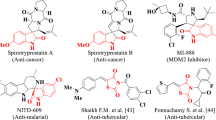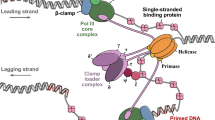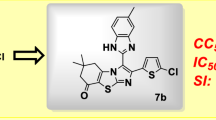Abstract
Two new cytotoxic 1,8-naphthalimide derivatives have been synthesized and characterized. Their biological activities as cytotoxicity and antimicrobial activities and inhibitory activities against DNA-polymerase were evaluated. The interactions of compounds with double-stranded- and quadruple-DNA have been studied by UV–Vis, fluorescent intercalator displacement, competition dialysis, circular dichroism and the findings were compared with the parent naphthalimide and the other compounds. The results show that both compounds (1 and 2) and the parent compound NI have strong cytotoxic activities against Beas-2B, MCF-7, HepG2 and MDA-MB-231 cancer cell lines, antimicrobial activities against Staphylococcus aureus ATCC 29213, Enterococcus faecalis ATCC 29212 and inhibitory activities towards Taq-polymerase and transcriptase. These novel cationic compounds 1 and 2 can stabilize G-quadruplexes DNA according to thermal denaturation experiments, they change the 3D structure of the DNA (see details in CD experiments) and they exhibit different binding affinities for q-DNA and ds-DNA revealed by spectrophotometric titrations and competitive dialysis studies.





Similar content being viewed by others
References
Mergny JL, Helene C (1998) G-quadruplex DNA: a target for drug design. Nat Med 4(12):1366–1367
Murat P, Balasubramanian S (2014) Existence and consequences of G-quadruplex structures in DNA. Curr Opin Genet Dev 25:22–29
Huppert JL, Balasubramanian S (2005) Prevalence of quadruplexes in the human genome. Nucleic Acids Res 33(9):2908–2916
Rhodes D, Lipps HJ (2015) G-quadruplexes and their regulatory roles in biology. Nucleic Acids Res 43(18):8627–8637
Palm W, Lange TD (2008) How shelterin protects mammalian telomeres. Ann Rev Genet 42(1):301–334
Harley CB, Futcher AB, Greider CW (1990) Telomeres shorten during ageing of human fibroblasts. Nature 345(6274):458–460
Dang CV (2012) MYC on the path to cancer. Cell 149(1):22–35
Sun D, Thompson B, Cathers BE, Salazar M, Kerwin SM, Trent JO, Jenkins TC, Neidle S, Hurley LH (1997) Inhibition of human telomerase by a G-quadruplex-interactive compound. J Med Chem 40(14):2113–2116
Burger AM, Dai F, Schultes CM, Reszka AP, Moore MJ, Double JA, Neidle S (2005) The G-quadruplex-interactive molecule BRACO-19 inhibits tumor growth, consistent with telomere targeting and interference with telomerase function. Cancer Res 65(4):1489–1496
Phatak P, Cookson JC, Dai F, Smith V, Gartenhaus RB, Stevens MFG, Burger AM (2007) Telomere uncapping by the G-quadruplex ligand RHPS4 inhibits clonogenic tumour cell growth in vitro and in vivo consistent with a cancer stem cell targeting mechanism. Br J Cancer 96(8):1223–1233
Chang SC, Archer BJ, Utecht RE, Lewis DE, Judy MM, Matthews JL (1993) 4-Alkylamino-3-bromo-N-alkyl-1,8-naphthalimides: new photochemically activatable antiviral compounds. Bioorg Med Chem Lett 3(4):555–556
Berque-Bestel I, Soulier JL, Giner M, Rivail L, Langlois M, Sicsic S (2003) Synthesis and characterization of the first fluorescent antagonists for human 5-HT4 receptors. J Med Chem 46(13):2606–2620
Andricopulo AD, Müller LA, Filho VC, Cani GS, Roos JF, Corrêa R, Santos AR, Nunes RJ, Yunes RA (2000) Analgesic activity of cyclic imides: 1,8-naphthalimide and 1,4,5,8-naphthalenediimide derivatives. Farmaco 55(4):319–321
Filosa R, Peduto A, Micco SD, Caprariis PD, Festa M, Petrella A, Capranico G, Bifulco G (2009) Molecular modelling studies, synthesis and biological activity of a series of novel bisnaphthalimides and their development as new DNA topoisomerase II inhibitors. Bioorg Med Chem 17(1):13–24
Johnson CA, Hudson GA, Hardebeck LKE, Jolley EA, Ren Y, Lewis M, Znosko BM (2015) Effect of intercalator substituent and nucleotide sequence on the stability of DNA- and RNA-naphthalimide complexes. Bioorg Med Chem 23(13):3586–3591
Brana MF, Ramos A (2001) Naphthalimides as anti-cancer agents: synthesis and biological activity. Curr Med Chem Anticancer Agents 1(3):237–255
Freeman CL, Swords R, Giles FJ (2012) Amonafide: a future in treatment of resistant and secondary acute myeloid leukemia? Expert Rev Hematol 5(1):17–26
Yıldız U, Coban B (2018) Novel naphthalimide derivatives as selective G-quadruplex DNA binders. Appl Biochem Biotechnol 186(3):547–562
Ou Z, Xu M, Gao Y, Hu R, Li Q, Cai W, Wang Z, Qian Y, Yang G (2017) Synthesis, G-quadruplex binding properties and cytotoxicity of naphthalimide-thiourea conjugates. New J Chem 41(17):9397–9405
Ou Z, Qian Y, Gao Y, Wang Y, Yang G, Li Y, Jiang K, Wang X (2016) Photophysical, G-quadruplex DNA binding and cytotoxic properties of terpyridine complexes with a naphthalimide ligand. RSC Adv 6(43):36923–36931
Peduto A, Pagano B, Petronzi C, Massa A, Esposito V, Virgilio A, Paduano F, Trapasso F, Fiorito F, Florio S, Giancola C, Galeone A, Filosa R (2011) Design, synthesis, biophysical and biological studies of trisubstituted naphthalimides as G-quadruplex ligands. Bioorg Med Chem 19(21):6419–6429
Liu X-W, Lu J-L, Chen Y-D, Li L, Zhang D-S (2011) DNA binding behaviors and cleavage properties of a Ru(II) polypyridyl complex. Inorg Chim Acta 379(1):1–6
Zimmer C, Birch-Hirschfeld E, Weiss R (1974) CD studies on the conformation of some deoxyoligonucleotides containing adenine and thymine residues. Nucleic Acids Res 1(8):1017–1030
CLSI. (2015) Clinical Laboratory Standarts Institute, Wayne, PA, Vol. document M07/-A10
Yıldız U, Sengul A, Kandemir I, Comert F, Akkoç S, Coban B (2019) The comparative study of the DNA binding and biological activities of the quaternized dicnq as a dicationic form and its platinum(II) heteroleptic cationic complex. Bioorg Chem 87:70–77
Coban B, Tekin IO, Sengul A, Yildiz U, Kocak I, Sevinc N (2016) DNA studies of newly synthesized heteroleptic platinum(II) complexes [Pt(bpy)(iip)]2+ and [Pt(bpy)(miip)]2+. J Biol Inorg Chem 21(2):163–175
Coban B, Yildiz U (2014) DNA-binding studies and antitumor evaluation of novel water soluble organic pip and hpip analogs. Appl Biochem Biotechnol 172(1):248–262
Fu PKL (2001) Turro C (2001) Transcription inhibition by Rh(phi)2(phen)3+. Chem Commun 3:279–280
Portugal J, Martin B, Vaquero A, Ferrer N, Villamarin S, Priebe W (2001) Analysis of the effects of daunorubicin and WP631 on transcription. Curr Med Chem 8(1):1–8
Takusagawa F, Carlson RG, Weaver RF (2001) Anti-leukemia selectivity in actinomycin analogues. Bioorg Med Chem 9(3):719–725
Yan C, Higgins PJ (2013) Drugging the undruggable: transcription therapy for cancer. BBA Rev Cancer 1835(1):76–85
Sorasaenee K, Fu PK, Angeles-Boza AM, Dunbar KR, Turro C (2003) Inhibition of transcription in vitro by anticancer active dirhodium(II) complexes. Inorg Chem 42(4):1267–1271
Mulholland K, Sindiquei F, Wu C (2017) Binding modes and pathway of RHPS4 to human telomeric G-quadruplex and duplex DNA probed by all-atom molecular dynamics simulations with explicit solvent. Phys Chem Chem Phys 19:18685–18694
White EW, Tanious F, Ismail MA, Reszka AP, Neidle S, Boykin DW, Wilson WD (2007) Structure-specific recognition of quadruplex DNA by organic cations: Influence of shape, substituents and charge. Biophys Chem 126(1–3):140–153
Heald RA, Modi C, Cookson JC, Hutchinson I, Laughton CA, Gowan SM, Kelland LR, Stevens MFG (2002) Antitumor polycyclic acridines. 8. Synthesis and telomerase-inhibitory activity of methylated pentacyclic acridinium salts. J Med Chem 45(3):590–597
Luedtke NW (2009) Targeting G-quadruplex DNA with small molecules. CHIMIA Int J Chem 63(3):134–139
Kieltyka R, Fakhoury J, Moitessier N, Sleiman HF (2008) Platinum phenanthroimidazole complexes as G-quadruplex DNA selective binders. Chem Eur J 14(4):1145–1154
Yıldız U, Coban B (2016) A comparative DNA binding study for heteroleptic platinum(II) complexes of pip and hpip. Bulgar Chem Commun 48(Special C):33–38
Uslan C, Şebnem-Sesalan B (2012) Synthesis of novel DNA-interacting phthalocyanines. Dyes Pigments 94(1):127–135
Eftink MR, Ghiron CA (1981) Fluorescence quenching studies with proteins. Anal Biochem 114(2):199–227
Monchaud D, Allain C, Teulade-Fichou MP (2006) Development of a fluorescent intercalator displacement assay (G4-FID) for establishing quadruplex-DNA affinity and selectivity of putative ligands. Bioorg Med Chem Lett 16(18):4842–4845
Largy E, Hamon F, Teulade-Fichou MP (2011) Development of a high-throughput G4-FID assay for screening and evaluation of small molecules binding quadruplex nucleic acid structures. Anal Bioanal Chem 400(10):3419–3427
Paramasivan S, Rujan I, Bolton PH (2007) Circular dichroism of quadruplex DNAs: applications to structure, cation effects and ligand binding. Methods 43(4):324–331
Gonçalves DPN, Rodriguez R, Balasubramanian S, Sanders JKM (2006) Tetramethylpyridiniumporphyrazines—a new class of G-quadruplex inducing and stabilising ligands. Chem Commun 45:4685–4687
Guittat L, Alberti P, Rosu F, VanMiert S, Thetiot E, Pieters L, Gabelica V, DePauw E, Ottaviani A, Riou J-F, Mergny J-L (2003) Interactions of cryptolepine and neocryptolepine with unusual DNA structures. Biochimie 85(5):535–547
Carrasco C, Rosu F, Gabelica V, Houssier C, De Pauw E, Garbay-Jaureguiberry C, Roques B, Wilson WD, Chaires JB, Waring MJ, Bailly C (2002) Tight binding of the antitumor drug ditercalinium to quadruplex DNA. ChemBioChem 3(12):1235–1241
Ragazzon P, Chaires JB (2007) Use of competition dialysis in the discovery of G-quadruplex selective ligands. Methods 43(4):313–323
Tomczyk MD, Walczak KZ (2018) l,8-Naphthalimide based DNA intercalators and anticancer agents. A systematic review from 2007 to 2017. Eur J Med Chem 159:393–422
Acknowledgements
We are grateful for the support of Bulent Ecevit University with Grant # 2014-72118496-04.
Author information
Authors and Affiliations
Corresponding author
Ethics declarations
Conflict of interest
The authors declare that they have no conflict of interest.
Research involving human participants and/or animals
This article does not contain any studies with human participants or animals performed by any of the authors.
Additional information
Publisher's Note
Springer Nature remains neutral with regard to jurisdictional claims in published maps and institutional affiliations.
Electronic supplementary material
Below is the link to the electronic supplementary material.
Rights and permissions
About this article
Cite this article
Yildiz, U., Kandemir, I., Cömert, F. et al. Synthesis of naphthalimide derivatives with potential anticancer activity, their comparative ds- and G-quadruplex-DNA binding studies and related biological activities. Mol Biol Rep 47, 1563–1572 (2020). https://doi.org/10.1007/s11033-019-05239-y
Received:
Revised:
Accepted:
Published:
Issue Date:
DOI: https://doi.org/10.1007/s11033-019-05239-y




